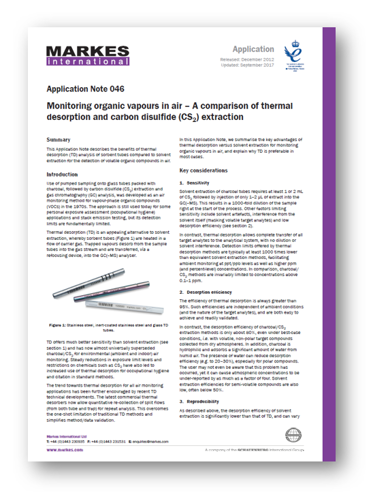
Monitoring organic vapours in air – A comparison of thermal desorption and carbon disulfide (CS2) extraction
Application Note 046
 Use of pumped sampling onto glass tubes packed with charcoal, followed by carbon disulfide (CS2) extraction and gas chromatography (GC) analysis, was developed as an air monitoring method for vapour-phase organic compounds (VOCs) in the 1970s. The approach is still used today, but its detection limits are fundamentally limited.
Use of pumped sampling onto glass tubes packed with charcoal, followed by carbon disulfide (CS2) extraction and gas chromatography (GC) analysis, was developed as an air monitoring method for vapour-phase organic compounds (VOCs) in the 1970s. The approach is still used today, but its detection limits are fundamentally limited.
Thermal desorption (TD) is an appealing alternative to solvent extraction, whereby sorbent tubes are heated in a flow of carrier gas. Trapped vapours desorb from the sample tubes into the gas stream and are transferred, via a refocusing device, into the GC(–MS) analyser.
In this application note, we summarise the key advantages of thermal desorption versus solvent extraction for monitoring organic vapours in air, and explain why TD is preferable in most cases.




